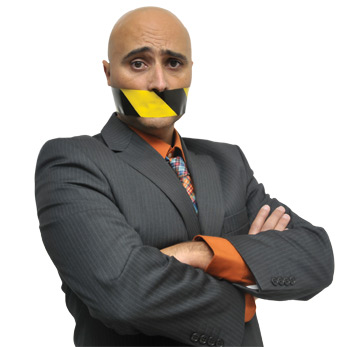
According to the Wor ld Intellectual Property Organization, cybersquatting cases were up by 17 percent from 2008 to 2009.
As a small business owner, would you allow a random person to stand in the middle of your business and verbally assault your good name to every customer within earshot?
Would you also allow the competing company down the street to send their salespeople into your business to try and lure your customers away from you? Of course not. You have likely spent years building your business from the ground up and put countless hours into ensuring that you provide a high-quality product or service that meets the needs of your customers. You do everything you can to promote the fact that you provide an outstanding product to your customers. What you wouldn’t do is allow someone to disparage your good name. And yet, this could be exactly what you are doing if you ignore the issue of cybersquatting.
What is cybersquatting?
Cybersquatting is registering, trafficking in or using a domain name with bad faith intent to profit from the goodwill of a trademark belonging to someone else [1]. This includes a practice known as typosquatting. Typosquatting involves taking a trademark and changing or adding letters to create a new domain name. The Anticybersquatting Consumer Protection Act (ACPA) helps protect trademark owners against both cybersquatting and typosquatting.
There are several reasons why individuals will cybersquat your trademarks. One of the most malicious involves an individual taking your trademark and creating a gripe site in an effort to damage your business. For example, if you own the trademark “XYZ Magazine,” someone could purchase the domain name www.xyzmagazine-scam.com and fill that Web site with defamatory content related to XYZ Magazine. They can refer to your business as a fraud and/or scam and post entirely false information about you and your business. Most importantly, the burden to stop them is on you. The ACPA does not protect against this kind of behavior, as it would encroach upon the First Amendment. However, you can take other actions, such as filing a defamation lawsuit against the individual, for example.
Another reason a person may want to cybersquat your domain is to earn money from the misdirected visitors by placing pay per click (PPC) ads on the domain. Imagine how many people mistype the word “Google” every day. If even a fraction of those people click on the ads that are placed on a typosquatted domain, it would be worth the $10 per year domain registration fee. However, this situation clearly falls under the ACPA’s domain and you will have several options available if it happens to you.
A cybersquatter could also be using the trademark in your domain to bring visitors to a competing business. Using XYZ Magazine as an example again, an individual with a competing magazine Web site interested in your target audience could purchase the domain www.xyzmagazine.net and direct all visitors to their magazine’s Web site. Those who mistakenly use the .net extension instead of .com would be misdirected from your side to that of the competition, causing you to lose business. This type of cybersquatting is also covered under the ACPA.
What can you do to prevent cybersquatting?
There are several preventative measures you can take to protect against cybersquatting. First, you must register your trademarks and copyright your Web site content, as this will provide you with legal leverage. (You can copyright your Web site online at www.copyright.gov.)
Next, you should purchase domain names. Domain name costs can vary based on which top-level domain (TLD) you choose. A TLD is simply the extension used when buying a domain name. The most common TLD is .com. A domain with a .com TLD will cost approximately $10 per year, but the cost is dependant upon the registrar you purchase it from.
If you try and register your trademark under all of the TLDs, you may quickly run out of money. There are approximately 250 TLDs that can be used by the general public. If the average cost is $10 per TLD, you are looking at a $2,500 bill every year for each trademark, misspelled trademark and derogatory term. For this reason, I suggest utilizing the top three to six most popular TLDs, which are: .com; .net; .org; .info; .biz; and .us.
It’s best to purchase your company name as a domain name first. If your company name is a somewhat common name, it may already be taken. For example, there are probably hundreds of “Joe’s Plumbing” shops across the United States, so the domain name joesplumbing.com would most likely be taken.
Next, grab your registered trademarks as domains. While these would be the easiest for you to obtain if someone cybersquatted them, you don’t want to go through all the red tape, hassle, money and wasted time when this issue is easily preventable up front. For example, around the time the Honda CRV became available, the domain name hondacrv.com became unavailable. It is currently registered to American Honda Motor Co., Inc. If Honda had left that domain name open to registration, there is little doubt that someone would have grabbed it to make a quick profit by either using PPC ads or attempting to ransom the domain.
What do you do once your domain or trademark has been cybersquatted?
Once your trademark or company name has been taken by a third party, your options will depend on what is being done with the domain. If a third party is running a gripe site, your course of action will be different than if they simply purchased the domain to sell it back to you. Therefore, your first step is to determine what the third party is doing with the domain. Ask these few questions before you choose your course of action:
- Are they profiting from the domain? In general, you will have more options if the domain name is being used for profit.
- Do they have an established business with the same name as the domain? If so, your options become more limited.
- Is it a gripe site? Gripe sites are generally protected under the First Amendment. While it may be possible to get the domain name back from a gripe site, it will most likely be very costly.
- Is your copyrighted content on the Web site? If the domain has your copyrighted content on it, you will have additional options under the Digital Millennium Copyright Act (DMCA).
First, you should try contacting the domain’s current owner to determine if he or she is willing to sell you the domain. Oftentimes, this will be the cheapest and quickest way to acquire the domain. You may be able to acquire the domain for a few hundred dollars by simply speaking to the current owner.
If offering to purchase the domain does not work and your copyrighted content is on another individual’s domain, try removing any financial incentive they have to own it by filing a DMCA violation with the search engines. The search engines may remove the offending site from their search listings if clear copyright violations can be seen. Filing a DMCA violation with the search engines may work if the offending site is primarily deriving its visitors from search engine traffic. If it is a typosquatted domain, filing a DMCA with the search engines may not prove successful, as visitors are most likely typing the domain name directly into the browser’s address bar. When the domain contains copyrighted content, you can also file a DMCA violation with the hosting company the domain uses. If the hosting company rules in your favor, they will remove the pages from the Web server and possibly cancel the hosting account.
You also have the option to file for Internet Corporation for Assigned Names and Numbers (ICANN) arbitration [2]. ICANN is the organization that regulates all Internet domain names and IP addresses. Arbitration is faster and less costly than a lawsuit. If arbitration is successful, the domain name will be transferred directly to you. However, arbitration does not allow you to recover any damages suffered.
Taking legal action should be your last resort. Odds are the legal process will be lengthy and costly. However, with this option, you have the possibility of recovering damages.
Conclusion
Cybersquatting, or owning a domain name related to your business, is done for many reasons. Though, the most common reason involves profit, as there are many people searching for a way to make a quick buck. If these people can profit off of your company’s good name, they most definitely will.
Resolving cybersquatting issues doesn’t necessarily have to be a lengthy process. Trying to work out the issue with the current domain owner first can potentially save you time and money. If that doesn’t work, removing the current owner’s ability to earn any income from the domain will provide additional incentive for the domain to be dropped. If the current owner remains obstinate, there is the option of ICANN domain name arbitration and, if nothing else, legal recourse.
Protecting your business from others attempting to damage or profit from your brand should be one of your top priorities— this includes protecting your brand online. By knowing what your options are and being prepared ahead of time, you can be one step ahead of those trying to profit from your success.
Sources:


